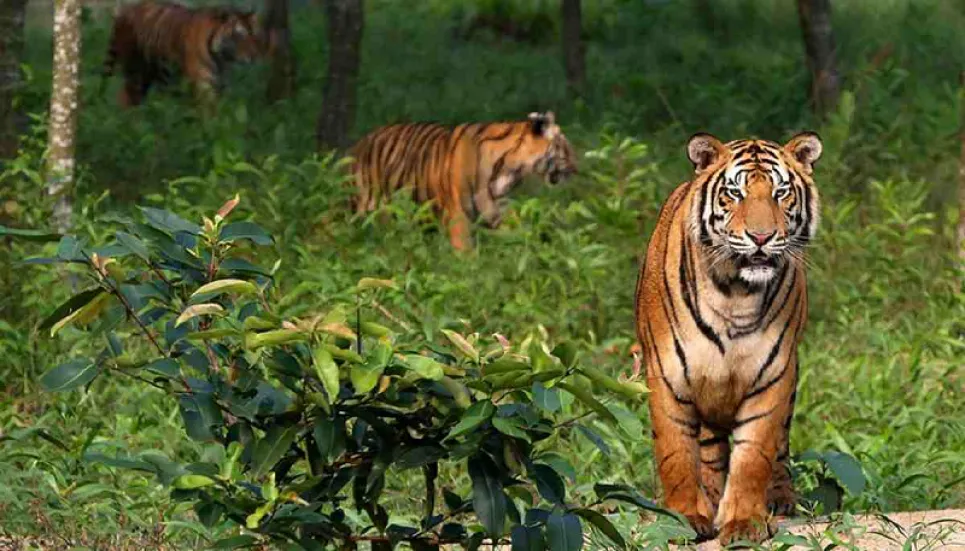
The Forest Department recovered a dead tiger's carcass from Rupar canal near Dublarchar at the Sundarbans in Bagerhat on Friday morning.
Muhammad Belayet Hossain, divisional forest officer (DFO) of the Sundarbans Eastern Division, said members of the Forest Department were on patrol on Friday morning when they saw the tiger carcass floating in Rupar canal of the forest.
The approximate age of the male tiger was 16 to 17 years, the official said.
This forest official believed that the Royal Bengal Tiger died due to aging as no wounds were noticed on the tiger's body.
However, an autopsy will ascertain the cause of death, he added.
Tigers' death in Sundarbans
Earlier, a tiger carcass was recovered from the Dhanchebaria sandbar on the Bhola River in the eastern part of the Sundarbans in March 2021. In July 2020, two tigers had died in the eastern and western parts of the Sundarbans in just five and a half months, said the Forest Department.
According to the Forest Department, 40 tigers have died in the Sundarbans in various ways from 2001 to January 28 of 2022.
Of these, 24 tigers died in the eastern part of the Sundarbans while 16 in the western part.
Sometimes tigers are killed by poachers. Besides, some tigers died after being beaten by the locals when they came out of the Sundarbans.
And some tigers died in natural disasters as well as due to illness and aging.
On the other hand, about 20 tiger hides have been recovered during this period.
According to the latest survey of 2018, there were 114 tigers in the Bangladesh part of the Sundarbans. However, the Forest Department cannot say how many tigers there are in the Sundarbans right now.
The Forest Department hopes that the number of tigers in the Sundarbans has increased due to various initiatives taken to protect the tigers.
Initiatives to save tigers
DFO Muhammad Belayet Hossain said the government has taken various initiatives to protect tigers. Habitats for wildlife, including tigers, have been increased in the Sundarbans.
In 2017, the government expanded the sanctuary area in the Sundarbans.
Out of the total forest area of 6,01,700 hectares, now the sanctuary area is 3,17,900 hectares which was only 1,39,700 hectares earlier.
To ensure the safety of tigers in the Sundarbans, along with patrol outpost activities, smart patrols are being carried out in the Sundarbans. The patrol of the forest department has also been increased in the border areas of the forest so that the tigers cannot leave the Sundarbans and go out to the locality. The Forest Department is on high alert in this regard, the DFO said.
Each tiger lives in the Sundarbans marking 14 to 16 sq km (home range) for their habitat. And the Royal Bengal Tigers roam throughout the Sundarbans.
Due to climate change, tigers are constantly facing salinity and natural disasters like storms and floods.
Tigers sometimes enter the locality as the river and canal of Sundarbans are getting filled with soil. And so tigers often die after being beaten by the villagers when they enter a forest-adjacent village. Also it was not possible to stop the crimes of poachers in the forest.
According to various sources, three of the eight subspecies of tiger have been extinct in the world. Tigers exist in only 12 countries of the world, including Bangladesh. Tigers have been identified as a critically endangered species by deforestation, poaching and trafficking around the world.
4th Asia Ministerial Conference on Tiger Conservation
This 4th Asia Ministerial Conference on Tiger Conservation, held on January 21, set the common goal of stabilizing wild tiger population and its prey, as well as strengthening the conservation efforts addressing new issues within Tiger Range Countries.
The representatives of the Tiger Range Countries resolved to ensure protection and prevent the degradation of tiger habitat as well as their ecological linkages.
The conference also resolved to undertake regular country level monitoring and assessment of wild tiger, prey, and habitat, and to strengthen enforcement capacity using appropriate and standard technology for continuous and systematic patrolling to safeguard tiger, prey, and habitat.
At the event, Environment, Forest and Climate Change Minister Md Shahab Uddin said the government is working with the determination to conserve wild tigers by achieving zero poaching targets with the active participation of the local community.
Adoption of a new clause in the national constitution to protect and improve biodiversity, wetlands, forests and wildlife; Wildlife (Conservation and Security) Act, 2012 has the provision of 2-7 years imprisonment and Tk 1 million fine for tiger poachers, he added.
He said National Tiger Recovery Programme (2017-2022) and second-generation Bangladesh Tiger Action Plan (2018-2027) also implemented which include tiger survey; genetic study; SMART patrolling and monitoring by drone inside the Sundarbans; capacity building programs for Forest Department officials or staffs as well as local community to ensure protection & conservation of the Sundarbans and Bengal tiger.
To mitigate tiger-human conflicts, the administration has engaged the local community in tiger conservation activities by forming Village Tiger Response Team (VTRT), Co-management Committee (CMC) and Community Petrol Group (CPG).
Wildlife Crime Control Unit has been established under the Forest Department to combat illegal wildlife trade.